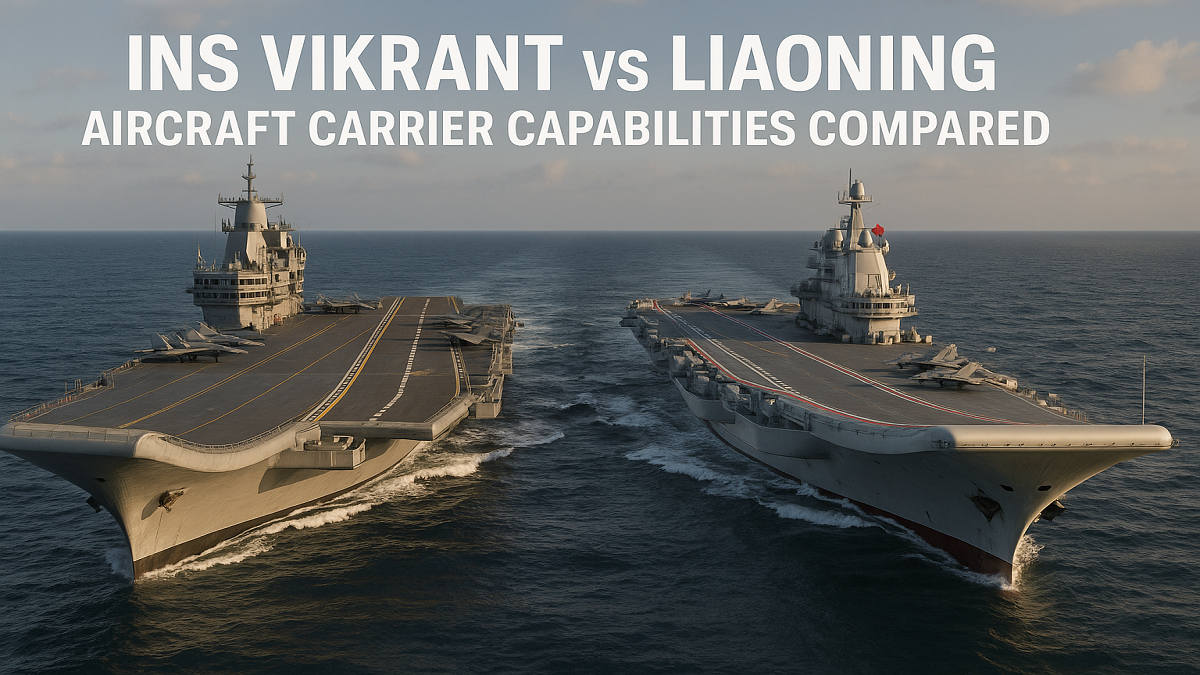Aircraft carriers are symbols of naval power and strategic dominance, often serving as floating airbases capable of projecting force across oceans. Two notable aircraft carriers in Asia are INS Vikrant (IAC-1), India’s first indigenously built carrier, and Liaoning, China’s first operational aircraft carrier, refurbished from the Soviet-era Varyag. This article explores these two platforms in detail, comparing their design, capabilities, operational roles, and strategic significance.
1. Origins and Development
- INS Vikrant represents a significant milestone for India, being its first homegrown aircraft carrier, designed and built by Cochin Shipyard Limited. Commissioned in 2022, Vikrant symbolizes India’s growing self-reliance in defense manufacturing.
- Liaoning, on the other hand, began as an incomplete Soviet vessel, acquired by China in the 1990s. It was refurbished and commissioned into the People’s Liberation Army Navy (PLAN) in 2012. Though based on an older design, it served as a foundation for China’s carrier program.
2. Design and Displacement
- INS Vikrant displaces around 45,000 tons and features a short take-off but arrested recovery (STOBAR) configuration. It uses a ski-jump ramp to launch aircraft and arrestor wires for landings, similar to its predecessor, INS Vikramaditya.
- Liaoning has a slightly higher displacement at approximately 58,000 tons and also employs a STOBAR system. However, being based on Soviet-era design, its architecture is bulkier, with a prominent island structure and thicker armor.
3. Air Wing and Operational Capabilities
- INS Vikrant is designed to operate around 30 aircraft, including MiG-29K fighters and Kamov-31 helicopters, with future integration expected for HAL TEDBF and MH-60R Seahawks. The carrier includes modern aviation facilities, a dedicated aircraft maintenance area, and advanced radar systems.
- Liaoning can carry around 40 aircraft, primarily J-15 fighters, which are naval variants derived from the Russian Su-33. However, these aircraft are heavier and face limitations during take-off from the ski-jump ramp, especially when fully armed or fueled.
4. Propulsion and Endurance
- INS Vikrant uses a conventional propulsion system, powered by four General Electric LM2500 gas turbines, allowing a top speed of around 28 knots and significant operational range suitable for extended missions in the Indian Ocean.
- Liaoning also uses conventional propulsion, powered by steam turbines, and achieves similar speeds. However, due to its older engineering lineage, its endurance and maintenance requirements are more demanding.
5. Combat Systems and Electronics
- INS Vikrant features a suite of indigenous and modern electronics, including the EL/M-2248 MF-STAR radar and advanced combat management systems. It is also equipped with Barak 8 surface-to-air missiles for self-defense.
- Liaoning is equipped with Type 348 radar systems, close-in weapon systems (CIWS), and a basic air defense suite. Although capable, it lacks the advanced network-centric warfare integration seen on more modern platforms.
6. Strategic Roles and Naval Doctrine
- INS Vikrant enhances India’s ability to project power in the Indian Ocean Region (IOR) and supports blue-water navy ambitions. It provides a platform for quick deployment, deterrence, and maritime security.
- Liaoning, in contrast, serves as a training and experimentation platform for China. It helped lay the groundwork for China’s newer carriers like Shandong and Fujian, which aim for more advanced capabilities including electromagnetic catapults (EMALS).



 Which Indian City is Known as the Footwe...
Which Indian City is Known as the Footwe...
 Which Desert is known as the Cold Desert...
Which Desert is known as the Cold Desert...
 Top-10 News Media Companies in the World...
Top-10 News Media Companies in the World...







